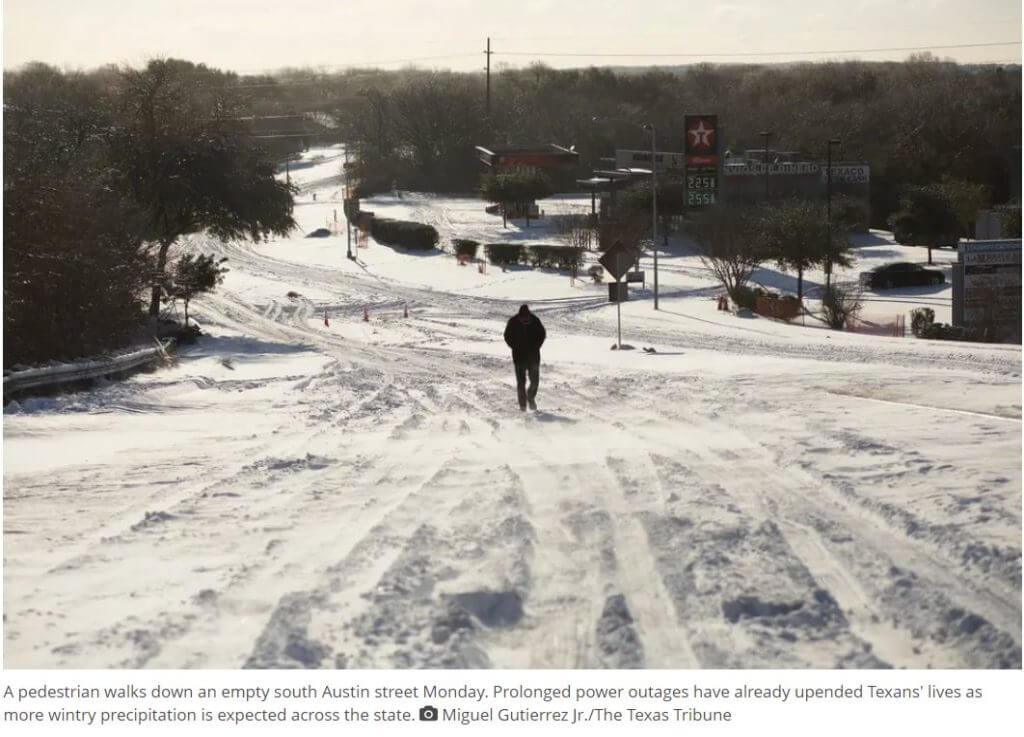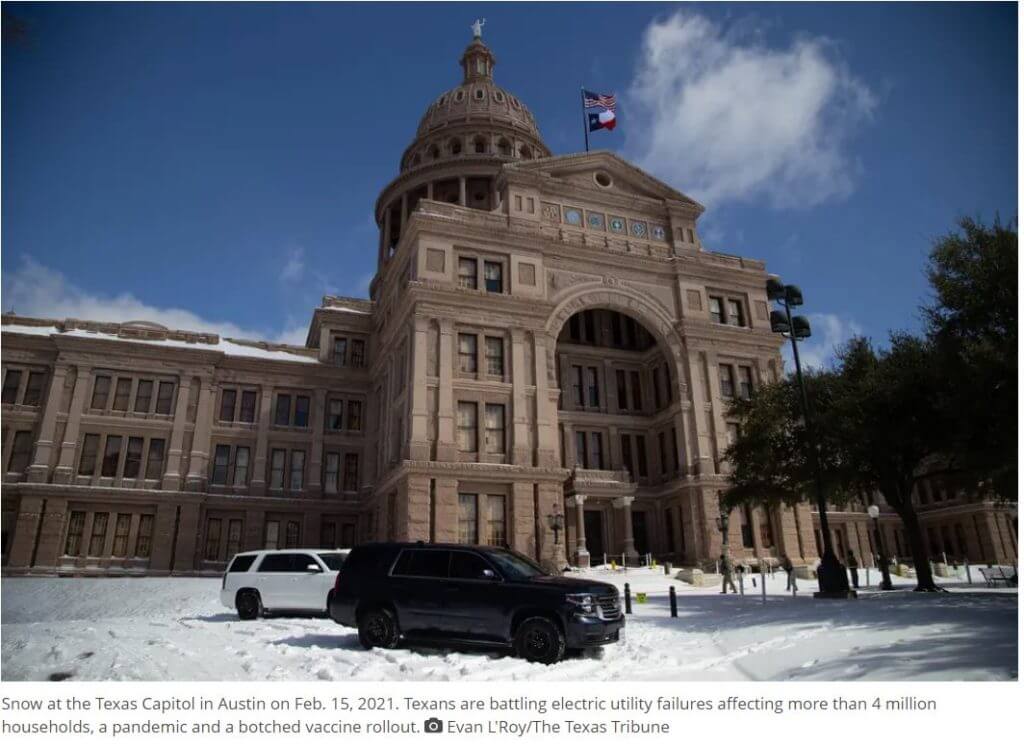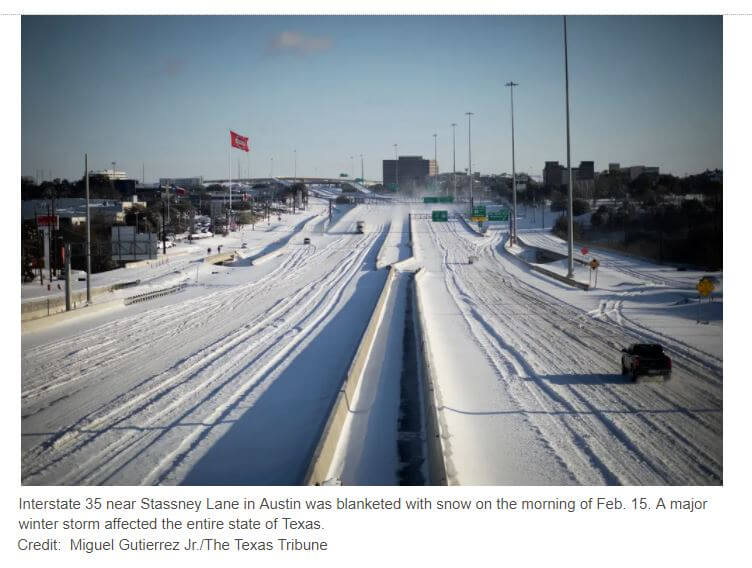


We’re tracking the fallout from the massive winter storm in Texas, which has brought widespread power outages and transportation problems.
BY TEXAS TRIBUNE STAFF FEB. 20, 2021UPDATED: 10:27 AM
What you need to know:
- Water outages persist as fallout from winter storm continues
- Federal disaster aid approved for 77 Texas counties
- Dozens of Texans died in storm-related incidents, but full toll may not be known for weeks
- AOC raises $3 million for Texas winter aid
- Texas failed to deliver state vital emergency information during storm
- Texas’ track record won’t make it easy to winterize energy infrastructure
Water outages persist as fallout from winter storm continues
The state’s power outage disaster has firmly transitioned into a water crisis. About half of the states’ population is still battling water infrastructure problems because of the cold weather — made worse as temperatures ticked up above freezing leading to pipes and water lines bursting.
Texans now face a cascade of frustrations and expenses. Insurance companies are bracing for claims rivaling those after major hurricanes, and homeowners are trying to find plumbers and electricians. — Reese Oxner and Shannon Najmabadi
Federal disaster aid approved for 77 Texas counties
The White House partially approved Texas’ request for a Major Disaster Declaration, Gov. Greg Abbott said Saturday. The federal government will provide individual assistance in 77 counties, including Bexar, Dallas, Harris, Tarrant and Travis — and public assistance, for emergency protective measures only, in all 254 counties.
“I thank President Biden for his assistance as we respond to impacts of winter weather across our state,” Abbott said. “While this partial approval is an important first step, Texas will continue to work with our federal partners to ensure all eligible Texans have access to the relief they need. The funds provided under the Major Disaster Declaration may provide crucial assistance to Texans as they begin to repair their homes and address property damage.”
Impacted individuals and business owners in counties included in President Joe Biden’s declaration can apply for assistance by registering online at www.DisasterAssistance.gov or by calling 1-800-621-3362 or 1-800-462-7585. — Perla Trevizo
Dozens died in storm, but full toll may not be known for weeks
Across Texas, deaths related to the winter storm continued to mount amid freezing temperatures, widespread power outages and a scarcity of clean water. While there have been reports that dozens of deaths are tied to the storm in Texas, experts say the death toll is likely far larger. And it could be weeks or months before the true magnitude is known.
“It’s a slow process. We may have preliminary information in weeks, not days,” said Chris Van Deusen, a Texas Department of State Health Services spokesperson. A statewide survey of deaths caused by the storm is underway, he said. But the state won’t have a good indication until death certificates are filed. — Shawn Mulcahy
AOC raises $3 million for Texas winter aid
U.S. Rep. Alexandria Ocasio-Cortez is in Houston after raising more than $3 million for Texas relief organizations helping those impacted by the historic winter storm.
The Democrat from New York posted a short Twitter video today which showed her volunteering at the Houston Food Bank, alongside U.S. Reps. Sheila Jackson and Sylvia Garcia of Houston. The city’s food bank is one of the organizations benefiting from Ocasio-Cortez’s fundraising efforts.
While Ocasio-Cortez represents the Bronx, she has ties to Texas, having participated in an education program called the National Hispanic Institute. During a July conference call with former San Antonio Mayor Julián Castro, she called the Lone Star state “home away from home.”
Texas failed to deliver state vital emergency information during storm
As millions of Texans fought to survive brutal winter weather without power and water, Gov. Greg Abbott told residents Wednesday to search for emergency warming shelters on Google and to call 311 for additional assistance.
The only problem: Many people lacked internet access, cellphone service and the ability to watch the governor’s press conferences. When the power went out, the state suddenly lost the ability to provide essential information to people desperately in need of help.
“Telling people to Google it is not OK. It’s the result of non-imaginative or non-planning in general, and it’s very, very unfortunate,” said Dr. Irwin Redlener, a senior research scholar for Columbia University’s National Center for Disaster Preparedness. “And I think there needs to be some accountability for why they hadn’t made the infrastructure more resilient, and also why they hadn’t planned for a situation where the power’s out.” — Duncan Agnew
Texas’ track record won’t make it easy to winterize energy infrastructure
Gov. Greg Abbott called for a law and funding to “winterize” Texas’ essential power infrastructure for the kind of extreme cold weather that created multiple crises this week.
Energy experts said that in some cases, retrofitting plants to withstand cold could be extremely difficult and expensive in Texas. Many of those plants already skimped on such upgrades due to the infrequency of prolonged and widespread subfreezing temperatures in the state. That’s despite a 2011 winter storm that also caused power outages.
Building new winterized infrastructure, though, often adds little to the overall cost of a new project, experts say.
“Our planning is based on outdated weather patterns, and if you use outdated weather, you never expect to freeze,” said Michael Webber, an energy resources professor at the University of Texas at Austin. — Erin Douglas

